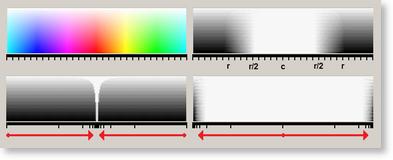Colorspace Use in ScanFix Xpress
RGB Colorspace
ScanFix Xpress stores color data in RGB format, and most operations that do not specifically involve color work in the RGB colorspace. The RGB format is also used by the Color Drop and Image Detergent functions, because the RGB colorspace is closer to perceptual uniformity than other simple colorspaces, such as YIQ and HSV, and because it is a close match to the abilities of the capture and display hardware. Color Drop and Virtual Bulb will both operate on spheres of color in the RGB colorspace.
Example of RGB Colorspace:
HSV Colorspace
Virtual Bulb and Detect Color both operate in the HSV colorspace, as they are dependent on the concepts of hue and saturation. Viewing the HSV colorspace as a cube, they operate on rectangular sections of hue. In the HSV colorspace, changes in hue, saturation, or brightness are independent of each other; this independence allows for a simpler, more robust implementation of these features than would be possible working in the RGB colorspace.
Example of HSV Colorspace:
Comparing RGB & HSV Colorspaces
Different colorspaces have different densities of color, which can be seen by a simple comparison of the RGB and HSV colorspaces. Values along the “V” axis, which represent pure grays, have a saturation of 0. At 0 saturation, the hue becomes irrelevant, so every gray value has 256 possible hues that will correspond to a single RGB value. When the brightness reaches 0, saturation ceases to matter as well. This means that any color with a 0 value for “V” in the HSV colorspace, of which there are 65,536 possibilities, corresponds to the single value 0, 0, 0 in the RGB colorspace.
A number of color operations use a 15-bit depth conversion, which greatly speeds up the colorspace calculations with minimal impact in quality. The difference in densities between colorspaces and the use of 15-bit color depths will result in some visible quantization of colors in machine generated images, but the level of quantization is low enough to be below the noise threshold on scanned images.
How Virtual Bulb Uses Colorspace Theory
The Virtual Bulb operation uses a custom colorspace to provide a flexible color dropout method. A traditional dropout scanner works by using a monochromatic sensor, to record a gray image, and a bulb colored to match the drop-out form's ink. With a red ink, a red bulb would be used; the red parts of the page would reflect nearly 100% of the red light, as would the white parts, resulting in both red and white appearing as white in the gray image. Green, blue, and black would all absorb nearly 100% of the red light, resulting in black. The same effect can be emulated on a color scanner by using just the input from the red sensors.
Example of the Virtual Bulb Operation:

The Virtual Bulb operation uses a custom colorspace that provides the ability to emulate a dropout scanner. In the simplest case, shown on the top right, Virtual Bulb works exactly like a dropout scanner would, generating a gray image equal to just the red values. However, unlike a dropout scanner, Virtual Bulb can warp the colorspace to achieve results not possible with a scanner. It can squeeze the colorspace, and shown on the lower left (radius of 1), or stretch it out, as shown on the lower right (radius of 884). By doing this, the effective range of the dropout can be narrowed to an extremely tight band of pure reds, or spread out to encompass nearly the entire spectrum. The inner radius still goes to white, and the outer radius to shades of gray, although the ratio no longer looks like half and half. Any color can be dropped by rotating the spectrum to put a different color in the middle; 42 to drop yellow or 170 to drop blue. Stretching the colorspace a different direction will brighten the target hue to remove “shadows” from the final form (refer to the topic, I Have Forms Scanned in Color & Need to Remove Some Colors or Data).
To be consistent with the Color Drop and Image Detergent functions, the term "radius" is used when setting up a Virtual Bulb drop, and values of 1 to 884 are used for the radius (lower left is a radius of 1, lower right, 884). However, since the operation itself isn't done by actually setting a radius, but rather by warping the colorspace, the results will not be the same linear response. The function used in the colorspace warping generates an exponential curve, which will provide approximately linear results near 170, but increasingly less perceptible changes as the values approach 1 and 884.



